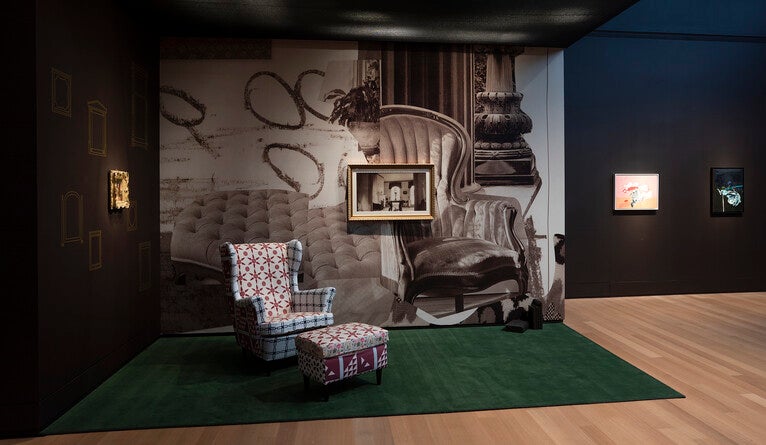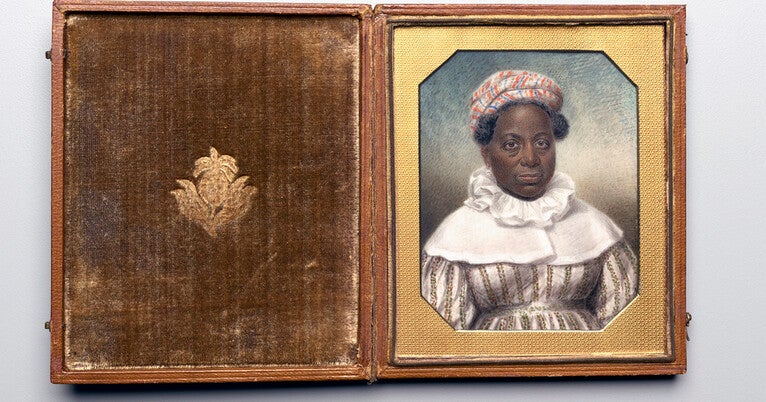Yale exhibition immerses viewers in pre-Emancipation settings
Rose Prentice, formerly enslaved, was in her mid-sixties when Sarah Goodridge, a noted miniaturist, painted her portrait.
Born in 1771, Prentice retained the surname of her second enslaver, John Prentice, who likely manumitted her, before or upon his death, in 1808. Decades after securing her freedom, Prentice moved to Boston’s Beacon Hill, where she performed housework for wages in the home of Elizabeth Tucker MacGregor, whom she had helped raise.
Prentice remained in Beacon Hill even after Tucker MacGregor left Boston, a parting, it’s thought, that motivated the miniature’s commission. Tucker MacGregor kept the portrait, which stayed within her family until Yale University Art Gallery acquired it in 2016.
Today, the watercolor-on-ivory miniature is the centerpiece of, and inspiration for, “Mickalene Thomas / Portrait of an Unlikely Space,” a historical-contemporary exhibition at the Gallery. In the exhibition, 30 small-scale portraits of Black Americans from the pre-Emancipation era — miniatures, daguerreotypes, silhouettes, and book engravings — are placed alongside 15 works by present-day artists (including Thomas ’02 M.F.A.) which, like their 19th-century counterparts, are focused on intimate subjects.
The show is divided into four sections with themes that reflect the nature of the objects on view: solitude, togetherness, posing, and holding.
Thomas — whose paintings and photographs of Black women posed in lushly decorated domestic interiors and whose installations immersing viewers in such settings have won international regard — co-curated the exhibition with Keely Orgeman, the Seymour H. Knox, Jr., Curator of Modern and Contemporary Art.
Five tableaus arranged throughout the galleries evoke mid-19th century living rooms. The first of these, located in the “Solitude” section near the exhibition’s primary entrance, features Prentice’s portrait, encased in glass, on a small circular center table. Prentice wears a plaid headscarf and a ruffled white collar. A pearl earring dots her right ear.
As with the other tableaus, a green area rug and a black drop ceiling create an intimate setting. Crown molding in the drop ceiling matches the crown molding on the gallery’s walls. An armchair upholstered in a variety of patterns — drawn from examples of 19th-century quilts and clothing handsewn by Black women — completes the scene. The chairs, which Thomas designed, are not intended for seating, but serve as props along with candlesticks, stacks of books, vases, and other items common to parlors of the period.

A photograph on an adjacent wall depicts the living room of a Derry, New Hampshire, home owned by Alanson Tucker, Eliza’s father, where Prentice worked for wages as a domestic laborer before relocating to Boston. The image, repeated three times in the exhibition, helped to inspire the look and feel of the tableaus, Orgeman said.
Key Jo Lee, who was a graduate student at Yale when the miniature was acquired seven years ago, performed preliminary research on the portrait, its subject, and the Tucker family. Orgeman later discovered that Prentice had a son, Leonard, with whom she had lost contact, although the reason for their separation remains unclear.
Four years ago, Thomas visited campus to view the miniature at Orgeman’s invitation, and was gripped by the work and what’s known of Prentice’s story. The pair soon began collaborating on the exhibition.
“The meanings of Prentice’s portrait unfold the longer you sit with it, and that’s the kind of engagement that I hope to facilitate with the other works [in the exhibition], too, by enveloping [visitors] within the transformed galleries where [they] will want to linger,” Thomas writes in an exhibition catalogue, which will be published later this month.
A second tableau features a reproduction of a hearth. Candlesticks on the mantle are painted to match the woodwork so that their presence recedes into the background, drawing the eye to the three silhouettes displayed between them, Orgeman explained.
Throughout the exhibition, historical works are displayed in wall-embedded cases so that the art seamlessly integrates with the architecture, Orgeman said. The cases also allow for the light levels to be adjusted individually to meet the specifications of lenders from private and public collections. (All works on display, except for the Prentice miniature, are on loan.)
“We wanted to allow viewers to get as close as possible to the works,” Orgeman said. “All of these small-scale portraits would have originally been viewed in private settings, in people’s homes, and they would have been held in people’s hands.”

“Repository I: Mother,” a sculpture by Sula Bermúdez-Silverman ’18 M.F.A. replicates the artist’s childhood dollhouse, but is composed of sugar resting atop a pedestal of pink Himalayan salt bricks. The piece references the history of sugar and its transformation from luxury to modern necessity, its place in creating power and empire, and how it changed global capitalism and industry, Orgeman said.
The house and bricks are illuminated, casting a warm glow reminiscent of firelight.
The next section, “Togetherness,” features objects that attest to interpersonal relationships of some nature. Two daguerreotypes displayed together in a reproduction of a hutch depict Christiana Williams Freeman, pictured alone, and her daughters, Isadora Noe Freeman and Mary Christina Freeman, depicted together. The Freeman family was highly active in the underground railroad in the Northeast, assisting freedom seekers on their journeys.
Thomas contributed three works from her “Courbet” series of Polaroid photographs. The sepia-toned images depict models and scenes that express the exhibition’s themes. For example, “Sleep,” a photograph of two models lying together in bed, reflect the ideas of togetherness and holding.
Two floral paintings by Wardell Milan ’04 M.F.A. move beyond the botanical to consider historical occurrences of racial injustice. “One Single Tulip,” a depiction of a tulip, symbolizes the subprime mortgages that fueled the 2008 global financial crisis — often compared to the “tulip mania” that caused the 1637 collapse of the Dutch economy — and were disproportionally offered to low-income Black Americans, exploiting their desire to own a home, Orgeman explained.
The second painting’s title, “Knight of the White Camelia, no. 6,” references the Knights of the White Camelia, a white supremacist terrorist organization that sought to prevent Black Americans from voting in the years immediately following the U.S. Civil War.
The section themed on “Posing” highlights the self-presentation of Black Americans in painted and photographic portraits. The section’s tableau is centered around “Portrait of a Creole Lady,” a miniature attributed to Julien Hudson, a French-speaking artist of mixed racial heritage who was counted among New Orleans’ antebellum population of free Blacks. The subject, who appears to be of mixed racial heritage, wears a dress and accessories that were associated with the French fashions favored by elites. A ship pictured behind her may suggest a connection to the port city’s thriving mercantile trade, Orgeman said.
The exhibition’s fourth and final section, “Holding,” focuses on portraits in which potential meanings can be derived from the sitters’ actions, including objects they hold, such as a banjo, carpenter’s triangle, or paintbrush — conjectures often made necessary by the lack of archival records concerning the enslaved or formerly enslaved.
A first edition of “Poems on Various Subjects, Religious and Moral” by Phillis Wheatley, the first enslaved woman of African descent to publish poetry in North America, anchors the exhibition’s final tableau. Displayed on a rectangular card table, it is opened to a famous portrait of Wheatley holding a quill pen and writing, which served as the 1773 book’s frontispiece. Lines from a poem included in Wheatley’s collection, “To S.M., a young African painter, on Seeing his Works,” written for Scipio Moorhead, an enslaved African painter and neighbor of Wheatley’s in Boston, are inscribed high on three walls within the exhibition.
“Mickalene and I felt it was a beautiful tribute from one artist to another,” Orgeman said.
In the exhibition’s closing work, “Imitation of Life,” by Betye Saar, a small figurine — the stereotypical representation of a black caregiver — stands inside an opened box atop a human mandible and a slice of watermelon. A drawing on the interior of the box’s lid depicts a Black woman with child seated on her lap. A newspaper clipping pasted inside of the box advertising the sale of an enslaved family, describes the mother as “a valuable Negro woman, accustomed to all kinds of housework,” and specifies that she could be sold separately from her two children.
But the figurine has agency: The woman wields a grenade.
“This is the statement with which we wanted to end the exhibition,” Orgeman said.
On Oct. 26, the Gallery is partnering with the Yale School of Art and local art incubator NXTHVN on a full day of panel discussions about the exhibition, ending with a keynote lecture by Thomas to mark the launch of the book that accompanies the show. All events are open to the public. For details, visit the Gallery’s website.














